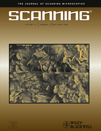Investigations on the leaf surface ultrastructure in grapevine (Vitis vinifera L.) by scanning microscopy
Abstract
Several Scanning microscopy techniques were used to investigate the leaf surface ultrastructure in the local “Razegui” grapevine cultivar (Vitis vinifera L.). Conventional scanning electron microscopy performed on glutaraldehyde-fixed samples allowed observation of well-preserved epidermal cells with an overlaying waxy layer. At a high magnification, the waxy layer exhibited crystalline projections in the form of horizontal and vertical platelets. Also, to avoid eventual ultrastructural alterations inherent in the use of solvents during sample preparation, fresh leaf blade samples were directly observed by environmental scanning electron microscopy. A classical image of convex living epidermal cells was observed. At 2400× magnification, epicuticular waxes exhibited a granular structure. However, high-magnification images were not obtained with this device. The atomic force microscopy (AFM) performed on fresh leaf blade samples allowed observation of a textured surface and heterogeneous profiles attributed to epicuticular wax deposits. AFM topography images confirmed further, the presence of irregular crystalloid wax projections as multishaped platelets on the adaxial surface of grapevine leaf. SCANNING 31: 127–131, 2009. © 2009 Wiley Periodicals, Inc.




